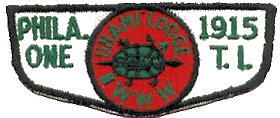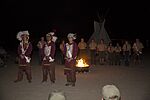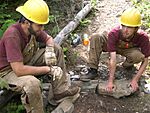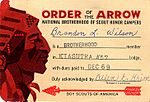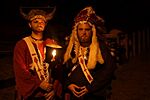Order of the Arrow facts for kids
Quick facts for kids Order of the Arrow |
|||
|---|---|---|---|
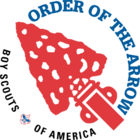 |
|||
| Previous Name | Wimachtendienk Wingolauchsik Witahemui (WWW) | ||
| Owner | Boy Scouts of America | ||
| Age range | 11–20 >(Co-ed youth) 21 and over (Co-ed adults) |
||
| Headquarters | Irving, Texas | ||
| Location | United States, Puerto Rico, Japan, Germany, Philippines | ||
| Country | United States | ||
| Founded | July 16, 1915 (108 years, 10 months and 3 days ago) |
||
| Founders |
|
||
| Membership |
|
||
| National Chief | David Gosik | ||
| National Vice Chief | John Andrew Segebarth | ||
| National Chairman | Chris A. Grove | ||
| National Director | Cortland Bolles | ||
|
|
|||
The Order of the Arrow (OA), previously known as Wimachtendienk Wingolauchsik Witahemui (WWW) is the honor society of the Boy Scouts of America (BSA), composed of Scouts and Scouters who best exemplify the Scout Oath and Law in their daily lives as elected by their peers. Started as a Camp Fraternity by E. Urner Goodman, with the assistance of Carroll A. Edson, in 1915, its goal was to reinforce the Scout Oath and the Scout Law. Started without approval of Boy Scouts of America (BSA), it became an "Official Experiment" of the scouting organization. In 1948, following an extensive review, it officially became a program of Boy Scouts of America.
While the OA is not a secret organization, it is an organization with "safeguarded" rituals. There are three main secretive ceremonies for the three levels of the Order: Ordeal, Brotherhood, and Vigil. These ceremonies are usually for recognition of leadership qualities, camping skills, and other scouting ideals as exemplified by their elected peers. Influenced by Scout camp customs, the OA uses "safeguarded" (privy only to members and legitimately interested adults) symbols, handshakes, and private rituals to impart a sense of community. Since the 1980s, concerned parents, scout leaders, and religious leaders may review the ceremony through a process set by the Order of the Arrow and parents can refuse for their child to take part in the ceremony as the membership is voluntary.
Inducted members, known as Arrowmen or Brothers (regardless of gender; as BSA and its programs are open to all genders), are organized into local youth-led Lodges that harbor fellowship, promote camping, and render service to Boy Scout councils and their communities. Each lodge corresponds to a BSA council in the area. Lodges are further broken down into chapters, which correspond to a district in scouting. Members wear identifying insignia on their uniforms, most notably the OA pocket flap that represents their individual OA lodge and the OA sash worn at official OA functions. The OA program sponsors several events, awards, and training functions.
It has foundations influenced by Freemasonry and uses imagery commonly associated with American Indian cultures for its self-invented ceremonies. Native Americans have criticized the OA's various symbols and "rituals" as cultural appropriation based on non-Native stereotypes of American Indians.Its Freemason ties have also been source of debates, in spite of its systematic removal of masonic terminology in the 1930s to avoid offending religious groups.
Contents
Origins
The Order of the Arrow was started as a Camp Fraternity by E. Urner Goodman, newly assigned Director of Treasure Island Scout Reservation on the Delaware River and assistant Camp Director Carroll A. Edson under the name of Wimachtendienk Wingolauchsik Witahemui. It was seen as a way to improve the summer camp experience and to encourage older Scouts to continue attending the summer camp It was not part of Boy Scouts of America at the time. The Fraternity was based on the Lënape dialect.
In 1921, the "known" Lodges organized themselves under a Grand Lodge as inspired by the Freemasons. A new Constitution was written and the ceremonies used in the early years were re-written. The following year, it became an Official Experiment of the Boy Scouts of America.
Throughout the 1930s, the Order of the Arrow went through a full review. The terminology used by the order was slowly replaced to sound less masonic and more Native American. This was a requirement from the Boy Scouts of America who wished to not offend the religious groups that represented almost half of their charter organizations at the time and this needed to happen before the OA could be fully integrated in BSA.
By 1948, two-thirds of the BSA's councils had OA Lodges. That same year, it announced at the 1948 NOAC that the Order of the Arrow was integrated as an official part of Boy Scouts of America Program.
Membership
More than 160,000 youth and adults are members of the Order of the Arrow as of August 2018. Unit elections of the OA are allowed in Scouts BSA, Venturing, and Sea Scout units.
There are three levels of membership:
- Ordeal
- Brotherhood
- Vigil Honor
Honorary membership was once bestowed in special circumstances, as with Franklin D. Roosevelt and Dwight D. Eisenhower, but this practice was officially discontinued in 1953.
Organization
The Order of the Arrow places great emphasis on being a youth-led organization. Only youth under the age 21 are voting members and are eligible to hold elected offices. Professional and volunteer adults are appointed to non-voting advisory positions at the chapter, lodge, and section levels.
The smallest level of organization in the Order of the Arrow is the chapter. The chapter is usually corresponding to a district in the local council. The chapter is led by the elected youth chapter chief, chapter vice chiefs, secretary, and a volunteer adult is appointed as the adviser, the district executive is the professional (staff) adviser. The chapters often hold monthly or weekly meetings together. The next largest unit of the OA is the lodge, which is chartered by a local BSA council. The lodge chief is the elected youth leader, the lodge adviser is a BSA adult volunteer appointed by the Scout Executive, and the lodge staff adviser is the council Scout executive or his designated council professional Scouter. The lodge youth officers, consisting of the lodge chief, one or more vice chiefs, a secretary, and a treasurer are responsible for organizing and leading the various programs and activities of the lodge. Many lodges have standing committees responsible for ceremonies, service projects, publications, unit elections, camp promotions, and dance teams composed of youth members.
Lodges are grouped into sections that are then grouped into regions. The section chief is the elected youth leader, a volunteer adult is appointed as the section adviser, and the area director (or his designate) is the professional (staff) adviser. In addition to the section chief, the section has two additional elected officers. The vice chief and secretary are elected immediately following the election of the section chief at the section's annual business meeting. All sections gather annually at a section conclave held in the late spring or early fall. It is the main duty of the section officers to lead the planning of this weekend with the help of the lodge chiefs in the section.
Like the Boy Scouts of America's Areas, The Order of the Arrow was formerly organized into four regions, Central, Southern, Northeast and Western Region; the boundaries of each OA region correspond with the boundaries of the BSA's regions. As of 2021, following the Boy Scouts of America's restructuring of these areas, the OA changed their region boundaries, now having only two. Each region has an elected region chief, a volunteer adult who is appointed as the region chairman to oversee its region Committee, and an appointed professional (staff) adviser, forming a 'Key Three' much like the Lodge and chapter system described above. Each region chief is elected at the national planning meeting the day after the election of the national chief and vice chief by a caucus of the section chiefs from the given region. The members of the region committee consist of the region chief, the region chair, all national committee members from the region, and other appointed adult volunteers. Each region annually has a gathering of all section officers and advisers. As a region, they are trained in topics relevant to their jobs. Each region also provides opportunities for Order of the Arrow members to go through a National Leadership Seminar. This weekend course is highly rated and a lasting memory for many members.
The national chief and the national vice chief are selected by a caucus of the section chiefs at the outset of the Order of the Arrow's national planning meeting. At the national level, the OA is headed by the National Order of the Arrow committee of which the national chief and national vice chief are voting members. The national adult leadership includes the volunteer national chairman and the OA director, a professional Scouter.
Ceremonies and Symbols
Today, the Order of the Arrow is famous within BSA for its uniform symbols. There are two types of symbols:
- Degree/Honor Symbols that indicate the level of membership in the national Order of the Arrow
- Lodge Symbols that indicate the membership to a specific local Lodge
The lodge membership often takes center stage over the level of membership on the Class A uniform. The pocket flap is sewn permanently to the shirt pocket itself and is worn even in casual settings while the ribbon or the sash are only used in more formal settings.
There are four ceremonies following the Unit Elections of OA candidates:
- Call-Out or Tapout (public)
- Induction (Ordeal) (secret)
- Brotherhood (secret)
- Vigil Honor (secret)
The requirements of to take part in the ceremonies are public but the content of the ceremonies are considered safeguarded and not to be shared with non-members without proper vetting.
Awards

Awards are separate and distinct from the membership levels of Ordeal and Brotherhood. Awards available through the Order of the Arrow include:
- Vigil Honor
- Founder's Award
- Distinguished Service Award
- Lifetime Achievement Award
- Red Arrow Award
- E. Urner Goodman Camping Award.
Events
The national OA committee also sponsors various national service opportunities, the oldest of which is the National OA Service Corps at the national Scout jamborees, at which Arrowmen have helped with many functions including shows and the Outdoor Adventure Program exhibit.
Firm Bound in Brotherhood Song
Ceremonies also utilize the OA Song, commonly referred to by its first line of lyrics as "Firm Bound in Brotherhood", and titled "Order of the Arrow Official Song" and "The Order of the Arrow Song" in the printed music score of official OA publications. It was written in 1921 by OA founder E. Urner Goodman to the Russian hymn tune "God Save the Tsar!" (Боже, Царя храни!), composed by Alexei Lvov in 1833.
High Adventure Program
The Order of the Arrow sponsors service groups to the four National High Adventure Bases that focus on conservation. Inspired by three gentlemen, Edward Pease, Eugene "Gene" Schnell and Marty Tschetter who gathered at a leadership summit at Philmont Scout Ranch in 1979, the Order of the Arrow High Adventure program was established. Originally starting with the Order of the Arrow Trail Crew at the Philmont Scout Ranch working to build new trails and repair old ones. This expanded to the Northern Tier National High Adventure Bases with the OA Wilderness Voyage, repairing the portage trails in the Boundary Waters Canoe Area, and then to Florida National High Adventure Sea Base in 2005 with Ocean Adventure, which works to remove invasive species on some of the Keys and promoting and carrying out of the Bleach watch program in the Florida Keys. After the addition of the third High Adventure Base, the Order of the Arrow implemented the OA Triple Crown Award in the summer of 2009, the OA began the OA Canadian Odyssey program which provided service similar to the OA Wilderness Voyage to the Quetico Provincial Park. In 2014, The Summit Bechtel Family National Scout Reserve began hosting the Order of the Arrow Summit Experience which gives service to the New River Gorge National River.
National Order of the Arrow Conference
The National Order of the Arrow Conference (NOAC) is a multi-day event which usually takes place on a university campus, bringing together thousands of delegates from OA lodges around the nation for training and activities. NOACs are held every two years, with exceptions made to align the event with significant anniversaries. As a youth-led organization, these national conferences are organized and directed by the elected section and region youth officers, who serve on committees responsible for various conference aspects under the leadership of the conference vice-chief. Events include training for programs, leadership and American Indian culture; competitions in athletics, ceremonies, cooking and American Indian dances; and exhibits on OA history, outdoor activities, and camping. There are also opportunities to talk with national leaders, perform service work and trade patches. Evening shows have different themes, including American Indian culture and recognition of dance competition winners, presentations of awards including the OA Distinguished Service Award and other entertainment.
Training
In addition to training courses available at a NOAC or section conclave, the OA offers specialized leadership training as weekend events for members: Lodge Leadership Development (LLD), National Leadership Seminars (NLS), and National Lodge Adviser Training Seminar (NLATS). LLD is a one-day or two-day event conducted by a lodge to train their officers and advisers. NLS's are conducted by regions for lodge officers and advisers. Many lodges send key officers to receive training. Typically, each region schedules three or four NLS weekends annually, at geographically dispersed locations within the region. NLATS is a training event for adults, usually held in conjunction with an NLS and conducted by regions, on the role of advisers in the OA.
Largely considered the adult equivalent of the NLS program, NLATS's primary objective was to provide advanced training to adults in each lodge. NLATS and NLS usually happened concurrently on the same weekend. The events were planned and executed by a staff of adults. After successful pilots in 2016, the Developing Youth Leadership Conference curriculum began replacing NLATS in early 2017.
Use and Appropriation of Native American Cultures
Goodman and Edson, the founders of the Order of the Arrow, opted to portray what they saw as Native American characteristics "as a sign of scouting excellence", and that the imagery, costuming, titles and imitation rituals "evoked a primitivist exterior Indian Other, vanished from the modern world but still accessible through ritual and its accompanying objects." Goodman and Edson established the OA at Treasure Island Scout Reservation as a Scouting honor society "based on a loose interpretation of" Hiawatha and the novel The Last of the Mohicans. Inductions of new OA members at Treasure Island involved OA members meeting around bonfires in "ritual Indian costume".
In the later twentieth century and beyond, the Order of the Arrow has been protested and criticized for engaging in cultural appropriation and spreading stereotypes of, and racism against, Native Americans. Protester concerns include OA's imitation of Native American ceremonies, regalia, and artwork they consider to be offensive.
The Chief Seattle Council of the BSA has written that modern ceremonies conducted by each OA lodge are "influenced by" the history and traditions of the Native American tribes indigenous to the areas the lodge serves, but use of Native American sacred objects by non-Native groups such as the Boy Scouts has been condemned by Native activists. Mother of former scouts Ozheebeegay Ikwe writes, "While native children in residential schools had their culture and language beaten from them, the Boy Scouts were using the language and their version of 'Indian culture' in their OA ceremony." She called the OA's use of headdresses, face paint, eagle feathers, and dancing with a pipe, "downright offensive". After researching the OA and watching their ceremonies she said, "Use of these items by Boy Scouts indicates that there is very little understanding of the Native people they claim to admire and respect." American anthropologist John H. Moore, an expert on North American Indian ethnology, wrote in an essay published in 1998 that "of all the institutions in American society, the Boy Scouts of America have probably done the most damage in miseducating the public about Native American cultures...[the] Order of the Arrow annually initiates thousands of boys into the martial, romantic version of Indian culture through ceremonies drawn from the writings of Longfellow and James Fenimoore Cooper".
David Prochaska, professor in the University of Illinois History Department states the Order of the Arrow is one element that "exemplifies the much larger phenomenon of 'playing Indian'...Boy Scouts, Eagle Scouts, Order of the Arrow. Order of Red Men. Campfire Girls. Woodcraft. Boston Tea Party. 'White Indians' – white New Agers as Native American 'wannabes.' ... To pursue the argument a step further, what is 'playing Indian,' 'playing Native,' 'playing an Other,' all about? It is about play, for one thing, in the sense of dressing up, masquerade, the Bakhtinian carnivalesque...It is also about appropriation, in the sense of taking on, assuming an other's identity, taking another's identity. The implication here is replacing one with another, silencing another, speaking for another."
Simon Mayo-Smith, a journalist and citizen of the Oglala Lakota Nation explains the concern of using Native American Headpieces:
“The headdress is reserved for our revered elders who, through their selflessness and leadership, have earned the right to wear one. It’s a spiritual garb, not just cultural; it’s not merely an addition to one’s attire. Wearing one, even an imitation headdress, belittles what our elders have spent a lifetime to earn.”
On July 23, 2018, the National Order of the Arrow Committee announced that they had received "many complaints surrounding these ceremonies from various American Indian tribes due to the manner in which they are conducted as well as the inconsistent nature in which they are performed." In 2019, the rules were changed: "Scouts will no longer be allowed to dress up as 'Indians' and incorporate Native American motifs into two of the order's more important ceremonies", according to the Voice of America, which noted also that "in spite of complaints from tribes across the country, Scouts continue to dress in 'Redface,' a term some use to describe the wearing of feathers and warpaint by non-Native Americans." In 2023, amid a backlash against stereotypes of Native Americans, the BSA held a survey among its members about whether to eliminate or alter the rituals, including those for the OA.
On December 23, 2023, the national Order of the Arrow leadership announced: "American Indian Activities (dancing, drumming, and crafts) will not be a part of the program at the 2024 National OA Conference." And, "There is not a single entity that speaks for the 574 federally recognized tribes/Indian nations across the United States and it is impossible for us to gain consensus amongst all the tribes/Indian nations. As a result, national-level American Indian programming is not appropriate."
While the OA bans America Indian programming at a National level, it leave this practice open at the local level. This left at the discretion of each local Lodge as each tribe will see things differently. The Lodges who already have relationships with their local tribes must continue to follow the directive provided by these tribes. Lodges who do not yet have this relationship but wish to continue to use American Indian traditions are expected to establish these relationships prior to continuing or starting using these traditions. These agreements should be done in writing.
Recent Freemasonry Debate
As evident in the history of the Order of the Arrow, the organization started with a large influence of Freemasonry. In the 1930s, it underwent a replacement of the Masonic vocabulary to avoid offending religious groups, and the OA has grown to be an important part of the Boys Scouts of America throughout the 20th and 21st Century. However, the debate about its relationship with Freemasonry is not over.
Those who put forward this idea believe that the Order of the Arrow is still today a Masonic organization and has not shed its Masonic nature. Several articles have been published since the 1990s expending on this idea. They point to the history of the OA and the current similarities that persist between Freemasonry and the present-day Order of the Arrow in its organization, secret ceremonies, and other rituals:
- Freemasonry, Scouting and the Order of the Arrow by S.M. Adkins with two follow-up articles titled Following Arrows and Yes, Virginia, it was called the 'Blood Rite'.
- Freemasonry Has Infiltrated the Boy Scouts? By John Salza
- The Order of the Arrow, Another Mason Ritual? By John R. Goodwin
- Scouting and Freemasons in Freemasons for Dummies by Christopher Hodapp
Today, the question of the ties of OA and Freemasonry is still active online in forums and blogs since at least 2010.
Denominations and Reasons
While most of the articles simply study the similarities between the two, the article by John Salza also touches on the spiritual question of the Order of the Arrow Freemasonry as it relates to the Christian faith. Indeed, several Christian denominations and many non-denomination churches view Freemasonry as incompatible with being a Christian and have provided their positions on the matter. These include:
- The Catholic Church: Papal ban of Freemasonry since 1738.
- The Church of the Brethren since 2009
- The Church of the Nazarene
- The Evangelical Lutheran Synod
- The Lutheran Church Missouri Synod
- The Orthodox Presbyterian Church since 1942
- The Presbyterian Church in America since 1988
- The Society of Friends (aka Quakers)
The Catholic Church was the first to prohibit it members from being part of any masonic organization. Started with Pope Clement XII, the Church perceived that masonic organizations required their members to put the membership to the Lodge above their membership of the Church and putting their secular allegiance to the secular fraternity above the communion of the Church. On November 13, 2023, the Vatican reiterated this position stating that Catholics "in Masonic associations are in a state of grave sin and may not receive Holy Communion". Other reasons put forward by some Christians in opposition to Freemasonry:
- it has all the characteristics of a religion with its symbols, rites and temples
- it involves and promotes idolatry
- it promotes a works-based view of salvation
- it promotes pagan and/or occult texts and doctrines
OA acknowledges Past Masonic Influence
The Order of the Arrow has not addressed directly the question of its present ties to Freemasonry. But on its official website, the OA does not shy away from its past by using the old Masonic terminology similar in a historical context and acknowledging that this terminology may well have come from the Masonic fraternal system:
"In 1921 Wimachtendienk, W.W. (a common way at the time of referring to what we know as the Order of the Arrow) was ready to have a national structure. Patterned similar to the Freemasons, it was decided that each lodge would become a member of the Grand Lodge."
"The usage of the term “Grand Lodge” appears to have come from the Masonic fraternal system that also calls their national organization a The Grand Lodge."
It also acknowledges that it was required to change this terminology in the 1930s:
"As part of the agreement made by the OA National Executive Committee with the BSA to become an official part of the Boy Scout program the OA agreed to change certain terminology effective January 1, 1935 (although not disseminated to local lodges until April 23, 1935). The BSA was concerned about heavy reliance on Masonic fraternal terms in the Order. So the term “lodge” which is what Masons call their local groupings was replaced with the word “tribe”. Instead of Unami Lodge and Owasippe Lodge, they became Unami Tribe and Owasippe Tribe. Likewise the Masons use of the term “Grand” to describe their highest governing body was changed to “National”. Thus the OA’s Grand Lodge would become known as the National Tribe and the Grand Chieftain would become known as the National Chieftain. Similarly, the term “Degree” became “Honor” and the term “Password” became “Admonition”. The term “Manitou” referring to a deity was completely eliminated from ceremonies, this being done to satisfy religious groups concerns."
Sash and Dash
The Order of the Arrow has the exclusive use of the right pocket flap for its colorful patch extremely popular among Scouts. This has led to a phenomenon known as "Sash and Dash" sometimes called "patch and Dash" has been a source of problem for the Order of the Arrow. It refers to Arrowmen who have gone through the election by their peers as well as the Ordeal and wearing the patch and/or sash but are never seen again. They do not participate in any Lodge event. The Order of the Arrow acknowledges the problem and has attempted to resolve the issue by providing training to retain active members.


